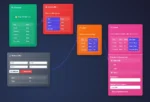
by tyler garrett | May 18, 2025 | Data Visual
Imagine being at the command center of a bustling city, where every movement, interaction, and event creates ripples impacting the broader ecosystem. To effectively anticipate outcomes and coordinate responses, you need sophisticated visualization tools that clearly depict sequences and dependencies in data over time. This challenge is not unlike the reality modern businesses face every day, managing complex temporal datasets to uncover strategic insights. Enter event droplines—a visualization technique specifically designed to clarify temporal sequencing, making it easier and faster to interpret data stories and act decisively. When paired with advanced analytical insights—such as those enabled through advanced Tableau consulting services—event droplines turn complex timelines into intuitive narratives. In this article, we’ll unpack how event droplines work, their strategic value, and how you can maximize their potential for impactful decision-making.
What are Event Droplines and Why Are They Essential?
In its simplest form, an event dropline is a vertical line drawn from a data mark down to a baseline time axis, clearly pinpointing precise temporal markers along a timeline visualization. These droplines help analysts identify the exact timing of specific events or actions quickly, especially valuable when datasets become complex with overlapping or closely spaced events. Unlike conventional timelines or line charts, event dropline visualizations can express clarity in chronological ordering—instantly helping users discern the flow of events and highlight critical moments immediately.
At a strategic level, clear and concise temporal visualizations are indispensable tools for leaders making rapid and informed decisions. Whether coordinating supply chain activities, tracing customer engagement journeys, or examining detailed digital marketing attribution models, dissecting timelines with precision clears the ambiguity around event-centric data. Without clarity, crucial insights can disappear in overwhelming visual noise. Employing event droplines can transform the way stakeholders digest temporal information, enabling them to swiftly comprehend dependencies, precedents, and consequences embedded within datasets.
Moreover, event droplines empower your data analytics team—whether comprised of a data analyst or a data engineer—to better visualize complex transactional logs or operational metrics. As a result, they can easily isolate events of interest, derive actionable solutions, and align team responsibilities with precision and efficiency.
Use Case Scenarios Where Event Droplines Excel
Effective Incident Management in IT and Technical Operations
Within technical operations or DevOps teams, swiftly visualizing sequences of actions, implementations, and system failures is crucial for optimal operations. Event droplines provide necessary clarity to instantly correlate system performance changes to recent software deployments. For example, visualizing network incidents or server requests through droplines quickly communicates event relationships, significantly shortening root cause analysis timelines. Combined with smart practices like adopting a distributed snapshot algorithm implementation, technical leaders can pinpoint faults precisely, drastically speeding up incident resolution.
Optimizing Customer Journey and Marketing Campaign Timelines
Marketing leaders can utilize event droplines to crunch timelines of customer interactions, from email opens to website visits and purchase completions. Traditionally overwhelming multi-touch attribution models suddenly become intuitive data stories. These visualizations aid sales and marketing teams in evaluating strategy effectiveness in real-time, rapidly enabling campaigns adjustment towards ROI optimization. Clearly defined event droplines provide insights into precisely when customer behaviors shifted, related to various campaign touchpoints, nullifying confusion and helping marketing strategists redirect budgets toward more promising initiatives confidently.
Similarly, event dropline visuals map user journeys with high granularity to track application usage and engagement trends across platforms. Leveraging these visualizations helps teams proactively address emerging customer pain points or behavior changes, enhancing user satisfaction and retention significantly.
Integrating Event Droplines in Your Existing Visualization Strategy
Introducing event droplines doesn’t necessarily require reinventing existing visualization practices. The strength of event droplines lies in complementing established timelines and other temporal charts like Gantt charts or traditional timelines. By pairing droplines with other visual tactics, data teams empower analysts to rapidly verify timestamps, relationships, and causal links without compromising detail or clarity.
Adopting event droplines often leverages your existing analytic tools such as Tableau, Power BI, or custom visualization libraries. For example, through structured guidance from Tableau consulting experts, your analysts can quickly integrate event dropline visualizations into dashboards, significantly enhancing communication of temporal stories and strategic decisions across your organization for faster alignment, collaboration and actionability.
Ensure best practices are well-documented internally and consistently applied across various data teams. Encouraging collaboration between technical team members, such as data engineers developing pipeline processes, and analytics team members responsible for interpreting and visualizing final datasets, ensures a seamless integration strategy. Understanding clearly the different skillsets and role specifics involved—such as explained in this exploration of data engineers vs analysts—facilitates smooth internal transitions and quicker uptake of event dropline visualizations.
Common Challenges in Temporal Visualizations and How Event Droplines Address Them
Analyzing temporal data often carries significant complexity. Common visualization graphics become crowded, unclear, or misinterpreted if events are closely spaced, frequent, or overlapping significantly. Traditional charts struggle to highlight precise event sequencing or accurately represent event density and clustering over time. Event droplines tackle these issues head-on by clearly delineating individual temporal marks and emphasizing exact occurrences, thus removing confusion and misinterpretation.
For instance, while troubleshooting complex software issues, such as resolving issues like the common “error 1084 – service running in safe mode”—accurately pinpointing the exact sequence and timing of related system events is critical. Event droplines eliminate uncertainty in interpreting timelines of technical logs, allowing you to swiftly isolate the sequence of occurrences leading up to your issue.
Additionally, event droplines strongly enhance resource management and capacity planning efforts. Leaders utilizing cloud services can better monitor significant events like spikes in resource use, scaling events, or billing periods impacting costs directly. Effective visualizations complemented by clear sequencing tools become integral to more informed and accurate cloud data services cost optimization strategies.
Unlocking Strategic Insights from Temporal Data with Event Droplines
Utilizing event droplines to dissect, simplify, and effectively communicate temporal data marks a strategic shift in decision-making capabilities. Droplines unlock deeper insights into how events relate over time, letting stakeholders focus on actionable conclusions rather than spending excessive time deciphering raw data sets. Furthermore, effectively visualizing temporal context helps organizations rapidly spot underlying trends or rapidly respond to risks and opportunities.
When optimized accessibility and user-friendliness meets deep analytic insight, event droplines become a powerful visual strategy. They clearly visualize a more diverse and complex flow of information, contributing significantly to organizational intelligence. As previously discussed in our comprehensive exploration of data diversity and its strategic value, embracing diverse data representation techniques helps ensure organizations leverage all available insights effectively.
Incorporating event droplines into your temporal data visualization practices positions your analytics program as a strategic enabler. It actively enhances the visibility of issues, optimizes operations, and contributes meaningfully to cross-departmental agility and informed decision-making practices. Partnering with knowledgeable visualization and analytics experts ensures seamless integration and maximized returns.
Conclusion
Event droplines deliver clarity and precision to temporal visualizations, empowering executives, operational managers, and technical specialists with quick, actionable insights previously buried in confusing visuals. Whether dealing with customer journey analytics, technical operations logs, IT troubleshooting, or complex business strategy analysis, event droplines radically simplify understanding temporal sequences. Embracing event dropline visualization, along with strategic expert consulting support, enriches your data strategy arsenal—driving smarter decisions and a significant competitive edge.
Ready to elevate your temporal visualization strategy? Reach out to analytics consultants at Dev3lop today.
Thank you for your support, follow DEV3LOPCOM, LLC on LinkedIn and YouTube.

by tyler garrett | May 15, 2025 | Data Processing
As organizations continue to scale their data analytics capabilities, the complexity and sensitivity of their data often intensify rapidly. Data security has evolved from a best practice into an absolute strategic imperative. Row-level security (RLS) has emerged as a powerful mechanism, empowering organizations to granularly govern data visibility based on user contexts. When implemented skillfully, RLS doesn’t just bolster your data security—it unlocks new avenues for innovation, collaboration, and informed decision-making. In this strategic guide, we’ll discuss how meticulously applying row-level security within your data transformation workflows not only enhances security measures but also ensures seamless, precise, and tailored analytics for every stakeholder within your organization.
Understanding Row-Level Security and Its Strategic Importance
Row-level security refers specifically to controlling access to individual data records or rows present in a database or analytics platform. It grants data administrators granular control, empowering them to dictate exactly who can view particular subsets of data. Instead of managing permissions at a table or database level—which is typically broad and insufficiently flexible—RLS enables finely-tuned access tailored toward user attributes such as departments, roles, geography, or organizational hierarchies.
The strategic benefit of adopting RLS is multifaceted. Importantly, it reduces risk exposure for sensitive data, ensuring only the authorized personnel can interact with critical or confidential information. Beyond security, RLS strategically supports the accuracy and efficacy of analytics initiatives—particularly in complex organizations where personalized visibility brings clearer insights and more immediate, actionable outcomes. For example, a regional sales manager accessing a data dashboard would automatically see only sales data relevant to their geographic scope, eliminating distractions and emphasizing operational relevance.
The power of RLS lies in providing the flexibility for scalable security that adapts dynamically to organizational structures and changing access requirements. Smartly implementing row-level control encapsulates meticulous data governance principles, enabling organizations to stay compliant and competitive as data privacy regulations continue tightening around the globe.
Data Preparation & Role Assessment for Row-Level Security
The successful implementation of row-level security begins with strategic data preparation and rigorous user role assessment. Data practitioners must first audit current data assets objectively, mapping sensitivity levels, hierarchical relationships, and the organization’s legal or compliance-related obligations. Taking such structured preparatory steps will significantly streamline the implementation process while minimizing exposure to regulatory compliance risks.
With your data clearly delineated, a comprehensive role assessment is paramount. Identify user roles, understand each role’s specific requirements, and thoroughly document users’ information access scenarios. Collaborate closely with stakeholder representatives from each team or business segment to ensure no critical detail is overlooked. Leveraging resources such as our PostgreSQL consulting services can provide valuable aid in expertly navigating the RLS implementation process, helping your business avoid potential oversights and pitfalls.
This collaborative effort empowers organizations to implement RLS smartly and accurately at scale, enhancing data-driven decision-making processes. After all, strategic role assignment optimized for row-level security greatly improves user experience by empowering each stakeholder to interact precisely with analytics that reflect their direct operational responsibilities.
A Technical Roadmap for Implementing Row-Level Security in Data Workflows
Transforming your RLS strategy from concept to practical implementation demands a technical roadmap. Initially, decide upon the database or analytics platform most aligned with your organizational goals. Technologies such as PostgreSQL provide precise tools and robust support for row-level security solutions. PostgreSQL, in particular, stands out due to its proven community-supported security features, extensive user base, and flexible integration capabilities.
To begin incorporating row-level security practically, optimize your implementation efforts using comprehensive data workflows. Building a data workflow helps clearly define data transformations, identify filtering logic, and specify conditions under which access to certain data rows is permitted. Businesses can leverage robust data science and analytics environments, like those covered in our guide on how to setup Anaconda3, a data science toolkit, to thoroughly test and validate RLS rules with precision and accuracy.
Establish well-defined, validated conditions and policies at this stage to intelligently streamline your organization’s RLS approach. Documenting all implementation stages clearly ensures easy maintenance and highly efficient troubleshooting in the future, contributing positively to overall system robustness and longevity.
Advanced Implementation Considerations for Complex Data Scenarios
Strategically managing row-level security becomes more challenging with complex and large-scale data scenarios. However, complexity is also an opportunity to demonstrate leadership through innovation. Complex data environments often involve multi-dimensional tables, diverse user hierarchies, or multi-modal datasets—such as those described in our article on multi-modal sensory analytics integrating audio-visual and text data.
When addressing these complex requirements, consider implementing context-aware RLS approaches. Contextual rules can conditionally grant or restrict data access based on various interconnected factors—geography, timing, volume, or dynamic user profiling information, significantly enhancing user experience through intuitive and appropriate information access.
Moreover, technologies like quantum computing promise unprecedented data processing capabilities, potentially amplifying the efficiency and depth of security implementations in the future. Explore opportunities, referenced in our insightful article on unparalleled processing speed unleashing the power of quantum computing, to optimally integrate emerging technologies into your RLS strategy. Keeping abreast of innovation ensures preparedness for sustained competitive advantage and exemplary data stewardship.
Monitoring, Optimization, and Ongoing Management of RLS
Row-level security isn’t a one-off implementation—it requires regular monitoring to ensure continued effectiveness and adaptability. Regular audits to assess RLS policies and continuous feedback from users should define routine operational processes. Monitoring helps pinpoint performance bottlenecks, identify security gaps, and verify compliance with evolving regulatory requirements.
Optimization plays a critical role in maintaining responsiveness and accuracy. Leveraging advanced data analytics techniques—for instance, by upgrading inventory analytics through strategies mentioned in our comprehensive guide on optimizing inventory levels through demand forecasting—can ensure that your RLS implementation constantly aligns with tangible business outcomes, fostering a data-driven organizational culture.
RLS policies inevitably evolve as organizations grow or pivot. Efficient data management processes also involve removing unnecessary data securely and promptly; our insights within removing rows of data from a table in SQL can provide valuable guidance wherever datasets need adjustments. Keeping your data lean, secure, and relevant guarantees faster access times, improved overall database performance, and reduced vulnerabilities or exposures.
The Strategic Advantage of Row-Level Security in Analytics Growth
Implementing row-level security positions your organization to harness data’s full strategic potential safely and responsibly. From isolating confidential information to personalizing analytics initiatives and optimizing operations, RLS functions at the intersection of robust security and innovative analytics growth.
As organizations increasingly utilize cross-platform data integration, services like our guide to sending TikTok data to Google BigQuery using Node.js exemplify how data transformation pipelines demand clear and secure access protocols. Row-level security ensures that the right information reaches the right individuals or automated processes at precisely the right time—maximally secure and minimally intrusive.
In the future landscape of accelerated digital transformation, sophisticated analytics, and increasingly stringent data security guidelines, strategic implementation of row-level security within your data transformation workflows is not just advisable—it quickly becomes an absolute necessity. For organizations maintaining forward momentum, adopting strategically planned RLS frameworks ensures you’re ready not just for today’s challenges but tomorrow’s opportunities as well.
Tags: Row-level Security, Data Security, Data Transformation, PostgreSQL, Data Analytics Strategy, Data Governance

by tyler garrett | May 14, 2025 | Data Processing
In a rapidly evolving data management landscape, successful organizations are no longer content simply collecting vast amounts of raw data; today’s competitive edge comes from enriching and contextualizing data at scale. As decision-makers navigate the complexities inherent in achieving insightful and actionable analytics, carefully constructed data enrichment pipelines become indispensable for unlocking the transformative potential embedded in datasets. From enabling advanced machine learning models to streamlining strategic decision-making via data visualization techniques, proficiently architected data enrichment pipelines form the strategic backbone of modern analytics initiatives. In this article, we will explore proven architecture patterns for data enrichment pipelines, equipping business and technology leaders with the confidence to make smarter, more informed strategic decisions.
Understanding the Role of Data Enrichment Pipelines
Data enrichment is about taking raw datasets and enhancing their value by integrating supplementary information, standards, or derived insights. By leveraging data enrichment techniques effectively, organizations can uncover hidden patterns, improve data quality, and turn ambiguous data into transparent, actionable insights. For instance, in healthcare analytics, as detailed in our recent exploration of data analytics transformations in Austin’s healthcare industry, data enrichment can be the differentiating factor in achieving predictive capabilities or pinpointing areas that demand immediate intervention. But establishing an effective pipeline architecture for these data enrichment processes is no trivial task.
An optimal data enrichment pipeline systematically moves data from ingestion through cleansing, merging additional sources, and applying enrichment logic all the way to robust analytic outputs. Well-designed enrichment pipelines not only reduce complexity but also contribute strategically by ensuring that downstream applications, such as Power BI reporting tools, analytical models, and artificial intelligence initiatives can rely confidently on finished data products. Understanding common pipeline architectures, patterns, and best practices significantly enhances both the performance and the business value these pipelines deliver.
Popular Data Enrichment Pipeline Architecture Patterns
Batch Processing Pipelines
A batch pipeline pattern handles significant volumes of data at scheduled intervals and focuses on intensive enrichment processes that don’t require real-time interaction. Consider large-scale overnight processing or end-of-week aggregation used in tasks like optimizing inventory levels through demand forecasting. Batch pipelines offer considerable flexibility by processing massive datasets in clearly defined time windows, ensuring accurate data cleansing, validation, aggregation, and enrichment.
In batch processing architectures, data ingestion occurs periodically and partitioned data undergoes transformation via scalable computation services. These pipelines favor stability and cost-effective resource utilization over immediate latency. However, architecture teams must carefully manage synchronization, monitoring processes, and the reliability of batches to avoid issues such as duplication or missing data. Additionally, batch patterns should include schema management aligned with proven practices to maintain consistency across evolved datasets, which we addressed thoroughly in our article on schema evolution with backward and forward compatibility.
Stream Processing Architecture
When business leaders demand near-instant analytics, nothing beats stream processing for rapid data enrichment. With businesses increasingly requiring real-time enriched insights for strategic decision-making—such as identifying fraud or immediate inventory replenishment scenarios—streaming architectures quickly emerge as a strategic necessity rather than a luxury. These pipelines continuously ingest data as it arrives from real-time sources, enriching datasets on-the-fly, and making outputs immediately available for consumption.
Technologies like Apache Kafka, Apache Flink, and real-time cloud processing solutions allow organizations to construct robust stream-processing pipelines. However, to ensure quality and reusability of real-time enriched datasets, a carefully balanced approach to latency optimization versus enrichment complexity is vital. Decision-makers must determine precisely which enrichments require immediate real-time delivery versus those which can wait for batch processes. Our expertise in constructing simplified yet powerful analytical architectures emphasizes clearly defined roles and boundaries as discussed extensively in our blog about analytical sandboxes versus production warehouses.
Lambda Architecture
Lambda patterns bridge batch and real-time worlds by running two parallel processing layers—typically batch and streaming—to achieve robustness alongside immediate responsiveness. These architectures accommodate multiple enrichment mechanisms while simultaneously delivering instant insights and precise, detailed analytics. Business leaders appreciate Lambda patterns because of this comprehensive flexibility within environments requiring both rapid-response capability and meticulous data complexity management.
Lambda architectures rely heavily on maintaining clear partitioning of computation layers (batch layer for accuracy and stream layer for real-time immediacy), synchronization, and eventual merging. Ensuring the seamless interplay between layers requires architecting data schema patterns that adapt cleanly within evolving operational demands. Integrating effective schema evolution strategies helps organizations maintain backward and forward compatibility, reducing the risk inherent in complex dual-layer architectures.
Addressing Challenges in Data Enrichment Implementations
Although domain expertise and sophisticated technological stacks enhance data enrichment tremendously, multiple challenges may still arise. One recurrent issue is the management and elimination of obsolete “zombie” datasets, those unused or redundant data fragments that continue to consume resources unnecessarily. Companies can protect efficiency in their enrichment pipelines by actively monitoring and removing zombie data, thus significantly improving resource allocation and pipeline efficiency.
Ensuring data accuracy, consistency, and reliability also rank among major concerns. Enrichment architectures must consider advanced validation mechanisms and automated schema governance practices, making robust data management flows paramount for quality outputs. Additionally, assessing your organizational maturity regarding data operation practices, known as DataOps, can help identify actionable areas of improvement. We offer strategic insights on this topic in our comprehensive guide to DataOps maturity assessment, guiding organizations toward a more disciplined, automated, and integrated pipeline practice.
Emerging Innovations and Evolving Best Practices
Forward-thinking organizations are now incorporating innovative solutions into their enrichment pipeline architectures. Machine Learning (ML) techniques, particularly differentiable data structures, are increasingly instrumental in introducing advanced analytics and adaptive enrichments. As we articulated in our overview regarding ML-enhanced analytics using differentiable data structures, embedding neural network models directly into pipeline operations allows continuous optimization and deeper insights drawn directly from pipeline processed data.
Strategically integrating ML-driven enrichments provides valuable predictive power and drastically reduces manual interventions. Yet to maximize ML advantages securely and reliably, data engineers must ensure proper system and database infrastructure setups. A seemingly mundane task, such as resetting MySQL root passwords, might become part of regular system protocols requiring expert attention—highlighting that groundbreaking enrichment capabilities must derive balance from robust infrastructure reliability practices.
Conclusion: Strategically Architecting Your Data Enrichment Future
Building an efficient, scalable data enrichment pipeline architecture involves thoughtful strategic planning and depth of technical expertise. Carefully choosing between batch, stream, Lambda, or hybrid solutions greatly influences companies’ readiness to innovate and harness rich insights effectively. At Dev3lop, our experts help companies architect enrichment strategies that align perfectly with their business needs, analytical maturity, and operational goals. Whether through customized Power BI consulting services or comprehensive pipeline assessments, selecting appropriate patterns ensures your organization gains a true competitive advantage from enriched datasets.
Your journey toward insightful analytics begins by recognizing enrichment’s strategic value, navigating its complexities confidently, and innovating with emerging trends. Ultimately, the organizations best positioned to benefit from data-driven innovation are those strategically investing in powerful, flexible data enrichment pipelines, powering insights that dramatically shape business outcomes.

by tyler garrett | May 12, 2025 | Solutions
In today’s rapid digital landscape, responsiveness isn’t merely a luxury—it’s an absolute requirement. Users now expect instantaneous load times and swift interactions, especially in data-intensive applications. If your interfaces lag or appear unresponsive, you’re likely losing engagement, conversions, and credibility. To stay ahead, organizations need an innovative approach to frontline data delivery—progressive data loading. By progressively loading data, development teams can ensure that user interfaces remain responsive, friendly, and accessible. At Dev3lop, we specialize in solving complex data issues and empowering businesses through cutting-edge data, analytics, and innovation services. As advocates of progressive data loading, we’ll dive deep into what this powerful method entails, how it can enhance your software solutions, and practical ways to implement it across your stack to deliver superior user experiences.
What is Progressive Data Loading?
Progressive data loading is a user-centric design and technology approach whereby data is loaded incrementally into the user interface, rather than loaded entirely upfront. Instead of making users wait until massive datasets have fully loaded—an experience that can feel frustrating and discourage interaction—the progressive loading model prioritizes rapid delivery of the most pertinent and visible data first. Additional data is brought onto the screen seamlessly and dynamically in real-time, allowing users to interact with already-loaded information while remaining data populates smoothly.
This method significantly reduces perceived loading time, enhancing user experience and effectively holding users’ attention. Progressive loading also employs concepts of asynchronous processing and streaming data architecture, allowing data queries to be fulfilled dynamically in the background. This can be achieved effectively using modern frameworks, libraries, and runtimes like Node.js, optimized for asynchronous and event-driven applications. To achieve expert-level architectural guidance and implementation support, many organizations choose to partner with specialized service providers offering robust Node.js consulting services.
For organizations dealing with large-scale data integration processes, progressive data loading complements established practices by ensuring rapid data delivery and interactive experiences. Integrating progressive loading alongside established ETL pipelines can further enhance data management efficiency; for more insights into effective data management strategies, explore our comprehensive article on The Role of ETL in Data Integration and Management.
Why Progressive Data Loading Matters: Improving UX
In a competitive digital environment, great user experience (UX) is paramount. Slow, cumbersome applications negatively influence user satisfaction, decrease interactions, impair productivity, and may significantly affect business outcomes. Research continuously highlights that users quickly abandon digital solutions perceived as slow or difficult to use. Consequently, ensuring your digital properties remain responsive and user-friendly directly translates into increased user retention, trust, and operational success.
Progressive data loading addresses key UX pain points like lengthy initial loading screens, data rendering bottlenecks, and performance limitations, especially for dashboards and analytics applications. For instance, consider performance-centric domains like data visualization dashboards analyzed in our article about Performance Tuning for Data Visualization Dashboards. Dashboards that incrementally load complex visualization data allow users to rapidly derive insights from partial datasets, enabling smarter and quicker decision-making, even when working with vast amounts of enterprise data.
Integrating progressive loading techniques can also enhance analytics-oriented applications related to public safety, operational improvement, and industry-specific insights like sales predictions. Explore how analytics enhances public safety and responsiveness through our resource on The Role of Data Analytics in Enhancing Public Safety in Austin. Progressive loading is not just a technical feature; it’s a UX strategy essential for data-driven future-focused businesses.
Key Components for Implementing Progressive Data Loading
Successful implementation of progressive data loading involves key technical and architectural considerations. Foremost among these are asynchronous API calls, partial and segmented data retrieval strategies, efficient caching, and delivering seamless UI interactions through intuitive UX design practices. It is critical for technical stakeholders to collaborate with experienced data architects and software development specialists to ensure these foundational best practices are executed properly.
Another critical aspect includes establishing reliable and scalable backend services, often built upon asynchronous web runtimes such as Node.js, capable of handling streaming large datasets efficiently. Modern approaches also integrate real-time streaming data handling through popular protocols and platforms such as Apache Kafka—as discussed extensively in our guide Building a Real-Time Dashboard with Streamlit and Kafka. Adopting such techniques not only enhances real-time data responsiveness but also maintains performance stability under peak loads.
Data integration and analytics teams should also align their progressive data loading solution with either in-house data platforms or commercially available ETL tools. Strategic alignment can be further explored in our detailed resource comparing options: Comparison of Open Source and Commercial ETL solutions. Clearly defined data flow pipelines embedded in these systems are crucial to provide rapid access to initial required datasets and subsequent incremental batches, enabling a rewarding and interactive user experience.
Real-World Use Cases of Progressive Data Loading
Progressive data loading is extensively utilized across various industries due to its efficiency in enhancing responsiveness and usability. A timely example is historical sales analysis applications used by businesses projecting future demand expectations. Users can dynamically access incremental historical insights without waiting for a completely loaded dataset, thus rapidly enabling quicker responses to emerging market trends. Our experts detail data analytic approaches for strategic decision-making in our popular resource Historical Sales Analysis: Unleashing Insights for Future Demand Expectations.
In the public sector, law enforcement dashboards that progressively load geographic and demographic data facilitate efficient resource planning and emergency response coordination. Similarly, real-time dashboards involved in operations monitoring—covering logistics, manufacturing, or supply-chain management—significantly benefit from progressive and incremental data loading techniques. By supporting fast reaction times and situational awareness, decision-makers are empowered with real-time insights without sacrificing performance or ease of use.
Industries and departments leveraging advanced data analytics increasingly rely on progressively loaded datasets. For further insights into the expanded importance of analytics across business landscapes, you may want to delve into our detailed resource on The Increasing Importance of Data Analysis in 2023, outlining the necessity of accessible, responsive data analytics solutions facilitated by progressive data loading.
Enhancing Transparency and Trust with Progressive Loading
With heightened demand for transparent data transformations and explainable computation graphs, progressive loading offers transparency by visibly demonstrating the underlying data processing steps within interfaces. Incremental data loading showcases users how data is processed, populated, and updated, gradually establishing confidence in underlying data. Users never experience a “black-box” environment and thus trust the data’s procedural correctness and timeliness.
Additionally, progressive loading allows teams to identify issues faster—early partial loads enable swift debugging and rectification, ensuring a higher quality end-product. Transparency and continuous monitoring further lead to better data quality management, as users quickly notice and communicate discrepancies or data anomalies visible in initially loaded segments, enhancing overall data reliability.
Importantly, transparent loading rituals establish credibility with technical and non-technical stakeholders. Increasingly, business executives appreciate transparency within analytics workflows, fostering confidence in business decisions supported by incremental data visualizations. Discover how enhanced visibility of analytic processes leads to business alignment in our article Understanding the Value of Data Analytics.
Conclusion: Making Your Interfaces Move at the Speed of Thought
Progressive data loading is more than technology—it’s a strategic vision driving responsive, performant, and trusted platforms for diverse industries. Implementing progressive loading requires expert backing, strategic alignment, and vigilant attention to user experience and data architecture. At Dev3lop, we occupy the intersection of analytics, innovation, and technology, ensuring our clients leverage efficient data-loading methods that enhance responsiveness, transparency, and trust in their software offerings.
Ready to explore progressive data loading in your environment? Talk to our experts and unlock greater responsiveness today.

by tyler garrett | May 8, 2025 | Solutions
Organizations today drown in data but thirst for actionable insights. Effective data management strategies hinge on your ability to transform intricate data landscapes into clear-cut vistas of informed analytics. A sophisticated semantic layer is your bridge from raw data to clarity, turning complex multi-dimensional analysis into understandable and actionable business intelligence. By optimizing your semantic strategies, you’re not only enhancing your analytics but laying the robust groundwork necessary to drive competitiveness and innovation. Let’s dive deep into why semantic layer optimization matters and how you can leverage it for multi-dimensional analytical brilliance.
Understanding the Importance of Semantic Layer Optimization
In the modern analytics ecosystem, a semantic layer provides an essential abstraction that simplifies data access for end users, thus enabling them to interact effortlessly with complex datasets. Optimizing this layer involves fine-tuning your semantic definitions, hierarchies, and logical models, ensuring responsiveness, accuracy, and agility for multi-dimensional queries.
Traditionally, organizations faced significant delays in deriving actionable insights because their systems lacked the agility required to handle detailed multi-dimensional data explorations. In contrast, organizations implementing advanced semantic layers streamline their decision-making processes significantly. A well-optimized semantic layer acts as the interpreter between technical database schemas and your analytical tools, converting raw data into understandable business terms, and ultimately helping your stakeholders gain facts-based clarity to drive innovation and competitive advantage.
When implemented strategically, a semantic layer optimization approach complements modern data warehousing techniques, like ELT processes. As we’ve previously explored, ELT makes more sense than ETL for the upcoming era of data analytics in 2025. By further aligning your semantic layer optimization efforts with this ELT approach, your team can derive insights at a rapid pace, without sacrificing performance or agility.
Strategic Benefits of Multi-Dimensional Analysis Through Semantic Layers
Multi-dimensional analysis allows businesses to quickly dissect large datasets from various perspectives, significantly enhancing decision-making accuracy. However, multi-dimensional data is often complex and challenging to handle without an expertly optimized semantic layer. With optimization, your organization’s analytics and BI tools perform efficiently, granting quicker access to key insights and improving business responsiveness.
One strategic benefit that immediately stands out is considerable performance improvement. Real-time or near-real-time analytics become possible, making your business agile enough to adapt to swiftly shifting market environments instantly. Businesses today need faster analytical insights to respond to market changes, customer behavior shifts, as well as operational challenges. Our experience developing robust semantic layers clearly demonstrates that optimized implementations substantially reduce latency and improve query responsiveness, boosting user-adoption and promoting informed decision-making.
Moreover, multi-dimensional semantic layer optimization enhances data accuracy by establishing clearly defined business rules and logic at the semantic rather than the application or reporting level. By setting precise permissions—something we’ve previously discussed in-depth in our guide to granting privileges and permissions in SQL—your semantic layer ensures data consistency across your organizational ecosystem. This creates a trustworthy single source of truth, eliminating miscommunication and conflicting objectives when making critical business decisions.
How Semantic Layers Drive Analytical Scalability and Innovation
As your business matures, data complexity escalates and demands more sophisticated analytical approaches. Semantic layer optimization directly supports this increasing analytical sophistication by simplifying and consolidating key data transformations, ultimately enabling users across your organization to leverage data independently. Teams can quickly build interactive dashboards, predictive analytics, and powerful insights without battling technical obstacles or performance degradation.
Semantic layer optimization also lays the groundwork for advanced analytical methods like predictive analytics, AI-led insights, and real-time forecasting. For instance, with optimized semantic modeling tied closely to your data integration architecture, you can effectively implement techniques we’ve outlined in our recent discussion around predicting the future of maintenance through data-driven solutions. Optimally structured semantic layers enable analysts and business users alike to perform detailed multi-dimensional investigations independently and swiftly.
Furthermore, collaborative innovation arises from the real-time insights produced by well-designed semantic layers. Rapid prototype development and building proof of concepts in real-time becomes simpler when data complexities are abstracted away from the user, streamlining the overall analytical process and fostering innovation across every business vertical.
Ensuring Data Quality Through Semantic Layer Optimization
Optimizing your semantic layer doesn’t merely enhance speed and flexibility, it also dramatically strengthens your data quality management. Poor data quality is frequently what prevents organizations from reaching their full profitability potential, and we highlighted this clearly in our insights around data quality as an overlooked factor in profitability. An effective semantic layer defines consistent data semantics, logical hierarchies, business rules, and validation procedures, ensuring data users receive accurate and reliable information every time they query the data.
By establishing well-defined semantic standards for your organization, you mitigate errors, eliminate redundancy, and instill consistency. This improved trust in your data leads directly to stronger decision-making processes and more actionable insights spread across all areas of your business. With semantic layers, you facilitate the integrity of analytics output, improving effectiveness in analytics-based strategies from marketing and sales to inventory management and financial reporting.
Equally important, optimized semantic layers greatly enhance your ability to implement analytics monitoring through robust observability practices. We covered this concept extensively in our guide to implementing a data observability strategy, emphasizing how monitoring data profiles at the semantic level uncovers anomalies early, reducing costly side effects downstream and maximizing trustworthiness in insights.
Proactive Steps to Optimize Your Semantic Layer
Your semantic layer won’t optimize itself—organizations require a strategic blueprint to lock in long-term analytical performance and scalability. Start by auditing your current analytics environment and carefully analyzing key operational bottlenecks. Consider partnering with a specialized analytics consultancy to identify optimization opportunities rapidly and provide actionable roadmaps. We’ve detailed the considerable advantages of collaborating with smaller expert consultancies in our article on working with a small data consultancy to accelerate your data strategy.
It is also imperative to ensure your data models, semantic layer design, and data infrastructure regularly align with business objectives. As your organization evolves, periodic evaluations enable adjustments that consistently support your analytical agility. Introducing robust DevOps practices, like automation and continuous integration, further streamlines your optimization processes by making iterative enhancements manageable and sustainable. You can learn more about integrating modern automation practices by reading our popular primer: Introduction to DevOps and the Role of Automation.
Lastly, leverage modern advanced analytics tools that seamlessly integrate semantic layers, such as Tableau. If your team needs targeted expertise in optimizing your semantic data architecture with tools like Tableau, consider exploring specialized analytics services such as those available through our advanced Tableau consulting services in Texas.
Closing Thoughts on Semantic Layer Optimization
Optimizing your semantic layer significantly amplifies your organization’s analytical capabilities, supporting seamless multi-dimensional analysis that drives actionable insights. As your analytics maturity accelerates, a carefully crafted and optimized semantic layer will empower decision-makers, promote informed innovation, and confidently guide your organization into a data-driven future.
Don’t underestimate the strategic value of semantic layer optimization: stay proactive, agile, and informed. Let your data strategy yield continuous competitive advantage, future-proof your analytics capability, and unlock genuine value from the data your organization generates every day.























